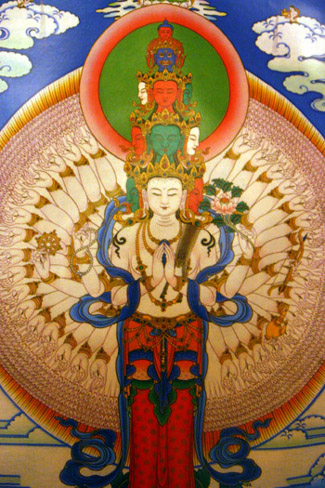
Suzan Doan
Acton Boxborough Regional High School - Acton, Massachusetts.
Tibetan
Buddhism and Sakya Masters
| THE THOUSAND ARMS AVALOKITESHVARA Photographed by S. Doan
The Thousand Armed Avalokiteshvara is one of many manifestations of the Bodhisattva of Great Compassion. According to legend, the Bodhisattva Avalokiteshvara made a vow to liberate all beings in all the realms of suffering, and would not rest until this task is done. After working for countless eons, the Bodhisattva realized that there were still innumerable beings yet to be saved. Having received the blessing from the Buddha Amitabha, Avalokiteshvara manifested into the bodhisattva of eleven heads, and a thousand arms. In this form, the Bodhisattva of loving- kindness is able to see in all directions to continue his work to save all beings. The image of Avalokiteshvara, depicted with a thousand arms and eleven heads has the following meanings: With the thousand arms in his sambhogakaya form, Avalokiteshvara as a shining wish-fulfilling gem represents the supreme Bodhicitta and the awakened mind, the enlightened thought wishing to benefit all sentient beings. Many Buddhists believe that the Dalai Lama is a reincarnation of Avalokiteshvara in his nirmanakaya form, visible to human beings. The Dalai Lama embodies virtuosity through his principles of peace and compassion. For more info., please visit: http://www.avalokiteshvara2005.org/bio.htm Copyright © 2006 Suzan Doan All Rights Reserved |
This site was created by Suzan Doan at the NEH Summer Institute "Cultures and Religions of the Himalayan Region," held at the College of the Holy Cross, Summer 2006
